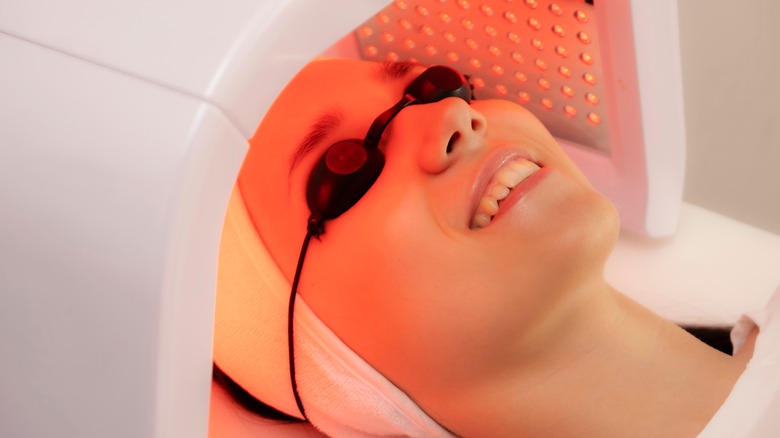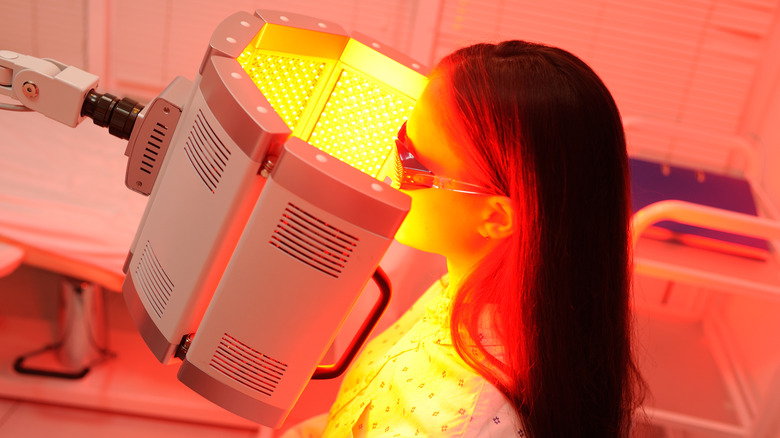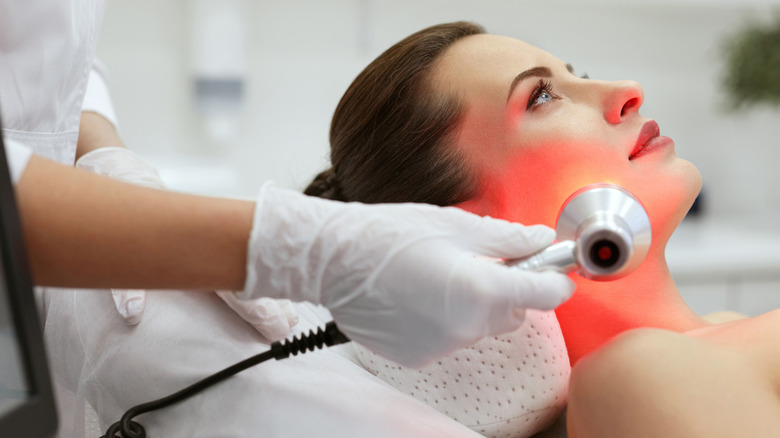Is Red Light Therapy Really The Multipurpose Beauty Solution It Claims To Be?
We may receive a commission on purchases made from links.
Skincare is like a never-ending hamster wheel. From as early as teenage years all the way until menopause, we will always find ourselves jumping from one skincare concern to another. After puberty acne comes enlarged pores, scars, and pigmentation. Just as we're done with pregnancy and have managed to get rid of pregnancy masks, we enter a stage where a loss of skin elasticity and wrinkles become inevitable. If you don't want to let your skin affect your confidence, you have to spend money to upkeep your appearance. Per SkinStore research in 2020, a U.S. consumer spends, on average, $322.88 a year on skincare, equating to a lifetime investment of $15,000 during 47 years of committed skincare shopping. Per Statista, the global skincare industry has generated $19.42 billion as of 2022.
Every skin condition requires a targeted treatment. For those battling multiple conditions at the same time, such as acne and wrinkles, the amount of money and energy spent on treatments is hard to predict. If you have gotten fed up with your journey to finding the fountain of youth, take heart! Red light therapy (RLT) — an emerging cosmetic skin treatment — has shown promise in treating multiple skin conditions at the same time. Celebrities such as Kelly Rowland, Emma Stone, and Kourtney Kardashian have jumped on the bandwagon and raved about their positive experiences with RLT. Let's take a look at the therapy in question and see if it's a boon or a bane.
What is red light therapy
Per the Cleveland Clinic, RLT is a therapeutic technique that involves exposing your face to low-wavelength red light to improve your skin's appearance, including aging signs, pigmentation, acne, and scars. Red light therapy is thought to work by penetrating mitochondria, the powerhouses of the cell that play a central role in energy metabolism and regulation of stress responses. This energy boost spurs the repair of muscle tissues, new cell growth, collagen production, blood circulation, and wound healing. Dermatologist Dr. Dendy Engelman points out (via Women's Health) that "RLT induces skin regeneration, whereas other therapies stimulate tissue repair by causing controlled damage to the outermost layer of the skin." For this reason, RLT is a great choice for addressing skin conditions.
The heat level used in RLT is low, so it doesn't burn or expose your skin to damaging rays. In terms of effectiveness, an experiment involving 128 volunteers published in the journal Photomedicine and Laser Surgery revealed some interesting findings. In comparison to the other participants, 57 of those who received RLT reported positive changes in skin tone, collagen density, and reduced skin roughness. However, given the lack of evidence, most experts find it difficult to draw conclusions on the effectiveness of RLT on the skin. To ascertain whether the therapy works for all of its stated purposes, more study involving more participants is required. Having said that, the only way to know for sure if RLP works for you is to try it yourself.
How to purchase RLT products
Generally speaking, RLT is safe to use. To receive treatment for RLT, you can visit a clinic or beauty spas where the therapy is offered with medical-grade devices. Many tanning salons, gyms, and wellness centers are also offering the treatment. Alternatively, you can opt for at-home use by purchasing FDA-approved RLT devices, which can take the form of LED masks and wands. According to Nina Desai (via Oprah Daily), RLT treatments are cumulative, so you might need to use the product consistently for a while before you can expect to see any results. Product-wise, Desai recommends buying an easy-to-use RLT device that has a wavelength of somewhere between 600 and 900 nanometers.
In terms of frequency, esthetician Shane Miller (via Rolling Stone) advises using the therapy every day, but only after consulting a dermatologist or esthetician to determine whether it is right for you. After cleansing and patting your face dry, put the red light device on your skin. If you use a wand or tool, Miller recommends applying a hydrating serum or oil to your face to let the device move around your skin seamlessly.
At the end of the day, no skincare treatment is one-size-fits-all. Until further definitive findings about RLT's universal effectiveness are made, you might want to stick to skincare treatments that target specific conditions and always speak to your dermatologist before trying out any new method.


